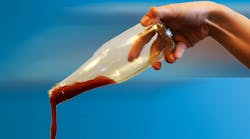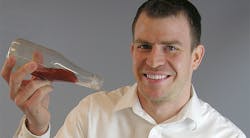Clean Getaway: Revolutionary Coating System Targets Manufacturing Waste
In May 2012, Dave Smith posted a 19-second video on YouTube of some ketchup pouring out of a bottle. His life hasn’t been the same since.
At the time, Smith was an MIT student working on a Ph.D. thesis about something called “liquid-impregnated surfaces”—basically, the science of keeping sticky liquids from sticking to stuff.
He had all the math worked out for a new approach to the technology and had a few big, industrial applications in mind for his recipe. So, just to prove the point, he mixed up a batch, coated a ketchup bottle, and shot a quick video. Nothing to it.
Today—nearly five years and about 700,000 views later—everything has changed. Smith has left academia behind and—with his former thesis advisor, Kripa Varanasi—has launched a $23 million startup that is positioned to disrupt every industry from consumer packaging to large-scale paint manufacturing. All from that one little YouTube clip.
Slippery Situation
That video, I should explain, isn’t quite as simple as I made it seem. Normally, pouring a bottle of ketchup involves a lot of shaking, strategic tapping, and long waits for the first drips to drop. But in Smith’s video, with a simple 45-deg tilt, the entire content of the bottle just sort of flows out. No shaking, no tapping, no ring of ketchup at the bottom, no ketchup trail to the lip. In less than 20 seconds, the bottle is completely empty, as though it had just been rinsed and washed. It seems almost magical.
“For us, manufacturing was always something we saw as a great opportunity,” Smith explains. “Like, if things don’t stick to packaging, they also aren’t going to stick to tanks. So there are opportunities there for manufacturers to cut their yield losses by keeping the product from sticking to the walls.”
This is the promise of the company’s latest release, CleanTanX. The new solution—customizable for every industry and application—offers an industrialized application of LiquiGlide’s “super slippery coating platform” aimed at cutting adherence of viscous liquids to blenders, reactors, and tanks used in manufacturing processes.
To highlight the significance of the opportunities here, LiquiGlide co-founder Varanasi noted in a recent release the issues paint manufacturers experience with their current processes.
“Paint sticking inside of mixing or holding tanks costs the industry more than 100 million gallons of lost product and billions of dollars per year in associated waste costs,” he said.
The goal of CleanTanX is to stop that adhesion before it starts—to let paint or crude oil or whatever sticky stuff you’re working with slide through the manufacturing process as effortlessly—and magically—as the ketchup from that original bottle.
Doing so could mean real, significant cost savings, and real, tangible disruption for the industry.
LiquiGlide estimates that this solution, while nearly eliminating product waste, can reduce water usage and lower cleaning costs by up to 95%—a monstrous number that Smith doesn’t even blink at.
“Numbers like that are inevitable if the stuff no longer sticks to the tank,” he says. “If there’s nothing left in the tank, there’s almost nothing to wash. So that eliminates one of the biggest sources of wasted water in many industries. “
Changing the Industry
This innovation presents a major departure from the standard practices in much of the industry—both on the manufacturing end and the systems designed to clean its equipment.
To understand the potential impact there, we turned to Spraying Systems Co.—a leading producer of spraying equipment designed to help manufacturers do exactly what LiquiGlide is promising: use less water, spend less time cleaning, and improve tank efficiencies across the board.
We found there is plenty of room for this to grow.
“Most companies I talk to don’t use any kind of lubrication in their tanks,” says Kirt Roosa, a sales engineer at Spraying Systems Co. with over 20 years of experience in the industrial lubrication space.
-Dave Smith, CEO & Co-Founder, LiquiGlide Inc.
“Without any treatment, you can get a lot of buildup in these tanks that will require high impact spray, plus hot water and chemical solutions to clean.
All of those process add up, he says.
“A lot times companies will completely fill a tank with hot water, let it soak, drain it, and then run one of our TankJet nozzles to create impact and clean it,” he explains. “If a customer could use something to keep product from sticking to their tank walls, they would potentially use less fluid and less heat to clean the tanks. All they would need is a nozzle and spray system for the final clean.
“There’s an easy ROI for them there.”
However, he hesitates before jumping into the unbridled enthusiasm many have for LiquiGlide and CleanTanX. There are, he says, a lot of legacy procedures and standards in many of these potential markets that will be slow to change.
“For the food processing industry, for example, the USDA standards are for food-grade stainless steel so they can be thoroughly cleaned, rinsed, and sanitized between every batch,” he says. “It’s an industry standard—a legacy standard maybe—but it has worked forever and it’s going to be very difficult to change.”
But that, Smith says, is LiquiGlide’s phase two plan.
Going Global
“We’ve talked a lot about mixing tanks, but there’s a lot more to manufacturing than just tanks and pipes where we can go with this,” Smith says. “If you look at a lot of manufacturing systems, adhesion of the product was a major factor in the design of the process.”
The fact that paint will stick to walls or that peanut butter won’t magically fall out of a mixer is a given. Elaborate manufacturing systems have been built to compensate for that. But when paint stops sticking, or when peanut butter does start rolling out, these systems will have room to change.
“There is an opportunity for people to redesign processes now that they don’t have these adhesion constraints,” Smith says. “This is the cure for liquids sticking to solid surfaces; the opportunities and applications for it are basically endless.”












